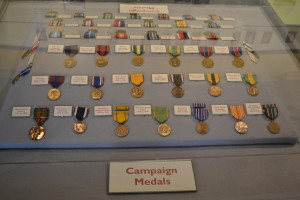
A display case of war medals is one of many features in the Benicia Historical Museum’s new permanent exhibit “Benicia Arsenal in War and Peace.” (Photo by Nick Sestanovich)
Long before Southampton…long before the Industrial Park…even long before First Street, Benicia’s permanent development consisted primarily of the Arsenal, a U.S. military reservation which operated from 1851 to 1964. A lot happened in Benicia and the world during that time, and the Benicia Historical Museum has condensed more than a century of history into one horizontal 20-foot timeline as part of its new permanent exhibit, “Benicia Arsenal in War and Peace.”
As Elizabeth D’Huart, the executive director of Benicia Historical Museum, was looking to spend as much time and energy on the museum’s permanent exhibits as its temporary ones, board members decided the history of the Arsenal would make a good focus. After all, what better place to learn about Benicia’s military past than in the one-time home of America’s only Camel Corps?
“When I first came to the museum five years ago, the question I asked myself when I was there and walking around was, ‘Knowing that this arsenal had been erected in the early 1850s and that it was open as a military base until 1964, what did we do during all those years? How did it fit in with the rest of the town and the history as it was unfolding during those many decades?’,” she said. “Our exhibits committee figured we could best reflect all of that information in a timeline.”
After museum board members and volunteers— including Jim Lessenger and Beverly Phelan— researched and condensed all the information, they used an inkjet printer to lay out the information on a 20-foot roll of paper and included tidbits about what else was happening in America during that period, including military and non-military history. The timeline extends from 1847, when the 252-acre land was purchased, to 1964. Included along the way are the names of every U.S. president during that period from James K. Polk to Lyndon B. Johnson, every war the U.S. took part in and every state that joined the nation in that time— including California itself.
However, the timeline is not the only feature of the exhibit. There are also stories of the Camel Corps, the California volunteer infantry unit during the Civil War, frontier duty and both the founding and closure of the Arsenal. There are also display cases filled with medals, badges and toy soldiers. Two of the cases were designed by Lessenger and Bob Rozett to resemble stacked ammunition boxes, and on the other side of the exhibit is a model of a Nike missile put together by Scott Reep of the exhibit’s sponsor; the Gizzi, Reep and Foley law firm.
D’Huart hopes people can envision themselves as part of the past as they view this exhibit.
“As always, I want people to imagine life here,” she said. “I want our residents to connect to the people who were here originally and the people who erected the Arsenal and came later, and I want them to make an emotional connection to the place where they live and where so many of the generations of Benicians lived and worked. The Arsenal was here before the city, the Arsenal and the city have grown up together side by side. The Arsenal is still a very important part of Benicia, both economically and physically.”
She also hopes people can see just how much changed from the Arsenal’s founding until it closed.
“I’m not sure there’s any exhibit in town or indeed locally that can speak specifically to the Benicia Arsenal,” she said. “This Arsenal was witness to and a part of military history that spans pre-state of California when the units were riding horses to our entry into the Space Age. That’s quite a remarkable arc of history.”
“Benicia Arsenal in War and Peace” will have its unveiling and opening reception at 1 p.m., Sunday, Nov.13 at the Benicia Historical Museum, located at 2060 Camel Road. Dr. Blaine Lamb, who has served as an archivist with the State Railroad Museum and California State Archives among other organizations, will be presenting a Power Point on Charles Pomeroy Stone, an Army officer who assisted with the construction of the Arsenal. He will be available to sign copies of his book “Charles Pomeroy Stone— Soldier, Surveyor, Pasha, Engineer.” This event is free and open to the public. For more information, contact the museum at 745-5435 or email info@beniciahistoricalmuseum.org.






Leave a Reply